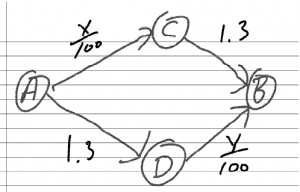Real life example of Braess’s paradox: Boston’s Big Dig
In class, we have discussed an important, yet unintuitive concept: the fact that adding an extra road or increasing capacity in a traffic network can actually increase the average travel time. This is called Braess’s paradox, and one real life example can be seen with one of Boston’s largest capital projects to date: The Big Dig.
http://www.boston.com/news/local/articles/2008/11/16/big_dig_pushes_bottlenecks_outward/
Boston faces a constant problem of traffic, mainly due to unorganized streets that were laid out before the advent of the automobile. The Big Dig, one of the largest capital projects in history, essentially increases the capacity of the central highway and its interchanges by placing the entire system as a series of tunnels under the central business district. A simplified map of Boston can be seen below, with the Big Dig areas highlighted:
http://upload.wikimedia.org/wikipedia/commons/7/78/Boston-big-dig-area.png
While the Big Dig did relieve congestion for some travelers, many people (including the article above) are arguing that the overall commute times are actually longer as a result. In one portion, the commute time has even doubled as a result of the increased capacity highway. The question is why? The article notes increased usage of the highway, but I believe that Braess’s paradox may play a role.
One important thing to note is that the financial district, which has greatly benefited from the new highway, is not the only common destination for commuters driving around Boston. Many jobs are located in other districts such as Cambridge, Back Bay, etc, causing several instances of Braess’s paradox similar to the example we have seen in class.
One potential example would be the commute from South Boston (A), a dense residential area, to Government Center (B), in the heart of Boston. Two possible paths would be to drive/bus to the Broadway Subway Station (C), and then take the subway to Government Center (B). A->C would use local roads and a portion of the highway that hasn’t changed capacity, and thus be sensitive to the number of drivers on the road, while B->C would utilize a form of mass transit and would be crowded much less easily. The other option would be to take Summer Street, which is a high-capacity avenue from A->D, where it enters the financial district of Boston and connects with the Big Dig highway. D->B navigates through city streets, and would thus be sensitive to congestion. The Big Dig adds a high-capacity highway from C->D, and thus completes the example as seen in class. Under the right conditions, the extra capacity from C->D could cause the Nash equilibrium we have seen to increase average commuter time.
South Boston is indeed one of the areas just outside the improvement area of the Big Dig, and part of where the article mentions increased travel times. Path A->C, specifically the Southeast Expressway, was noted to have increased congestion. This article is interesting because we can apply a specific example of Braess’s paradox that we proved in class to a real life example and suggest Braess’s paradox as a factor in increased travel times after the completion of the Big Dig.

